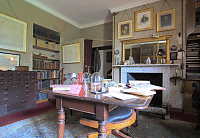|
|
 |
|
Bromley
|
 |
|
A country village and potential world heritage
site located three miles south-west of Orpington. The name was first recorded in 1283 and derives from the Old English ‘dun’,
a hill. It is claimed that the Post Office encouraged its spelling with an ‘e’ on the end to avoid confusion with
County Down in Ulster. This is a very scattered village, with weatherboarded cottages and brick and flint houses dotted around
in all directions but especially to the south. A chapel was built in 1291 and may have stood on the site of St Mary’s
Church. The fabric of the present church dates primarily from the 16th century. Downe Court was built in 1690 on the site
of an earlier manor house, which was probably surrounded by a moat. English Heritage has placed Downe Court on its register
of buildings at risk because it is ‘starting to show the effects of long term neglect’. On Luxted Road, a handsome
house called Petleys was built in the early 18th century and later became a home of the Wedgwood pottery family. In 1842 Josiah
Wedgwood’s daughter Emma came to live at Down House, a former parsonage at the southern end of the village, with her
husband Charles Darwin. The great scientist took a daily stroll around a circuit of the grounds known as the ‘sand walk’,
set up a laboratory in a brick hut and cultivated orchids in the greenhouse. Darwin lived at Down House until his death in
1882 and he wrote all his most important works here, including On the Origin of Species. Downe remained a farming village
into the 20th century, producing fruit and vegetables for the London markets. With its isolated location , the village attracted
walkers and cyclists to its tearooms and pubs. Down House became a Darwin museum in 1929 and was acquired by English Heritage
in 1996. Darwin’s study (shown in the image below), where he did most of his writing and microscope work, has been recreated
from photographs. Crammed with books, files and specimens, its amenities included a spittoon and a discreetly curtained privy.
Modern educational displays fill the rooms of the first floor.
 |
 |
|
|
|
 |

|
| The rear of Down House, and part of the 'Sand Walk' that Darwin took each day for 'thinking time' |
To the south-east of the house is Downe Bank –
or Orchis Bank, as Darwin knew it. Now a Kent Wildlife Trust property, the wood is rich in orchids and provides one of Britain’s
best displays of bluebells in spring.
In 2009 the government nominated Down House and the surrounding area in which
Darwin walked and thought as a world heritage site that it called ‘Darwin’s Laboratory’. As the Department
for Culture, Media and Sport pointed out: ‘Few properties and their environs can claim to have been as central to the
life and work of one person as Down House’. However, Unesco’s world heritage committee rejected the bid in August
2010.
|
 |
|
|
|
|
|
Postcode area: Orpington, BR6
Further reading: Janet Browne, Charles Darwin: The Power of Place, Jonathan Cape, 2002

Text and selected images are reproduced with the permission
of Chambers but may differ from the published versions
All content © 2005–2010
|
|
|
 |

